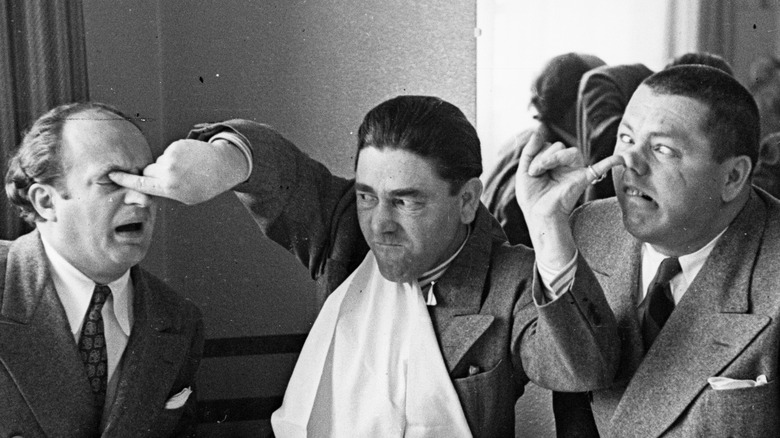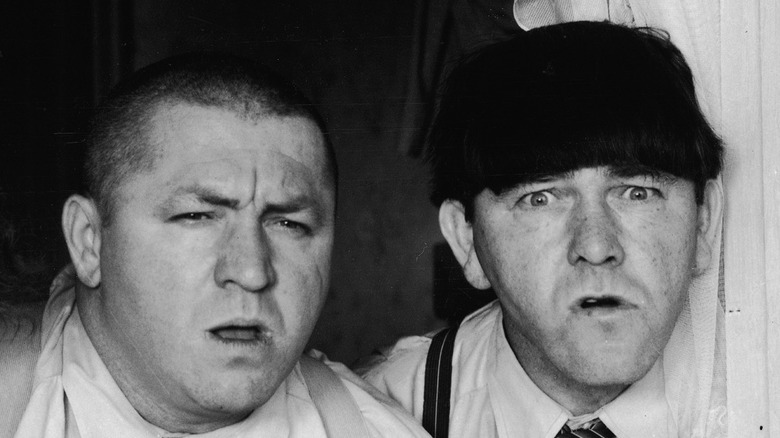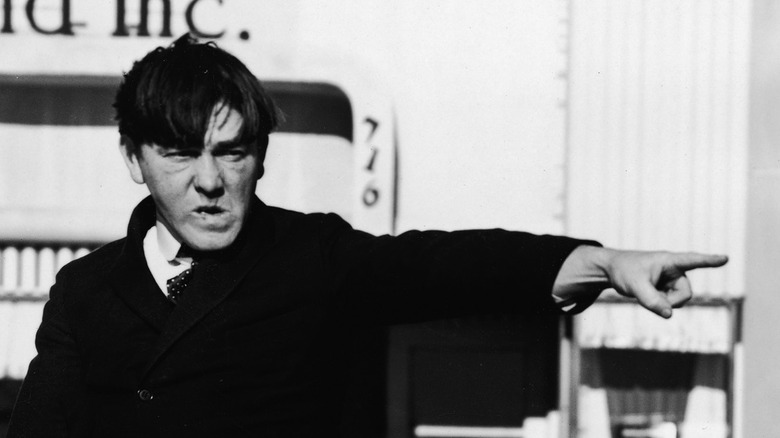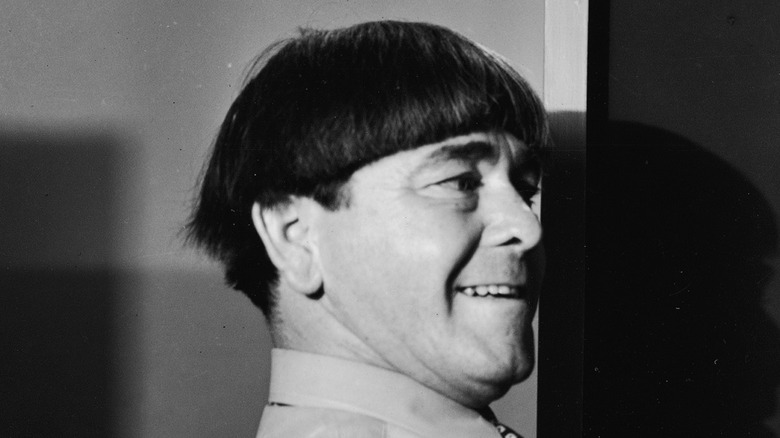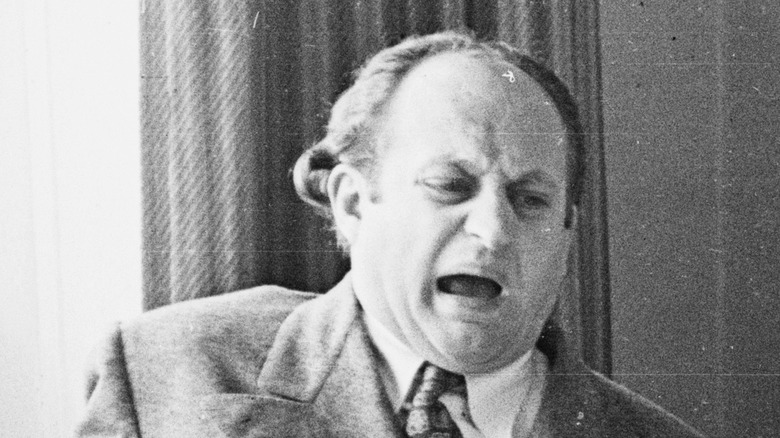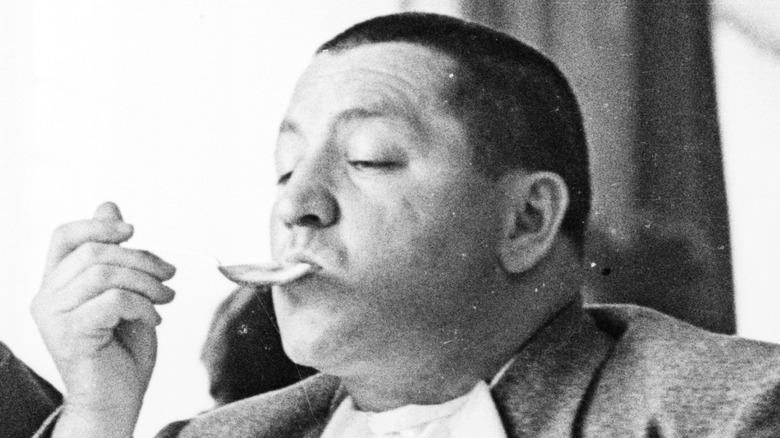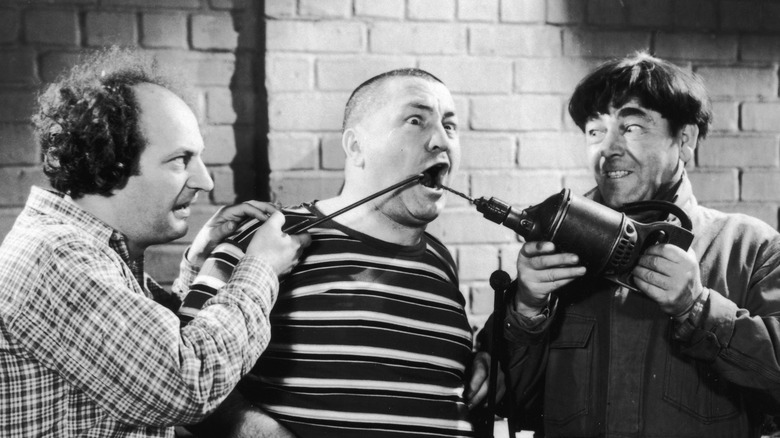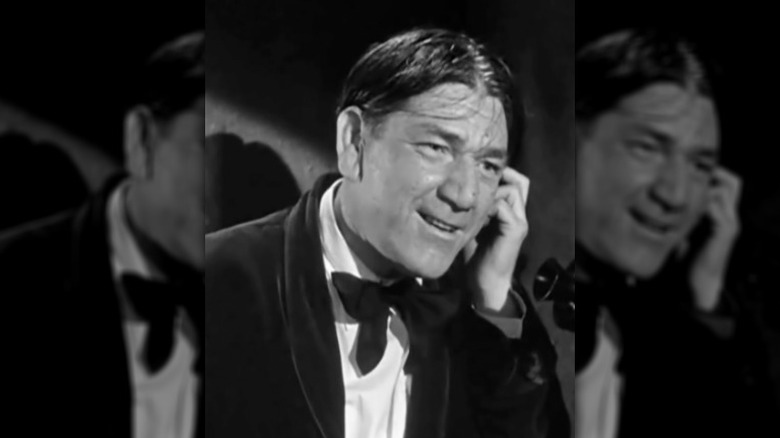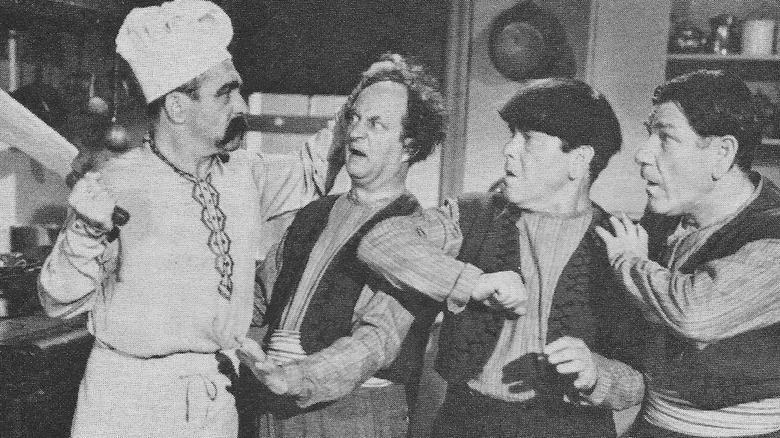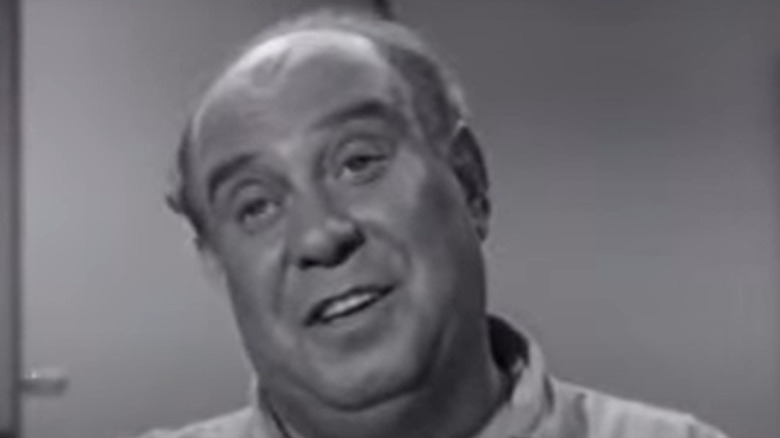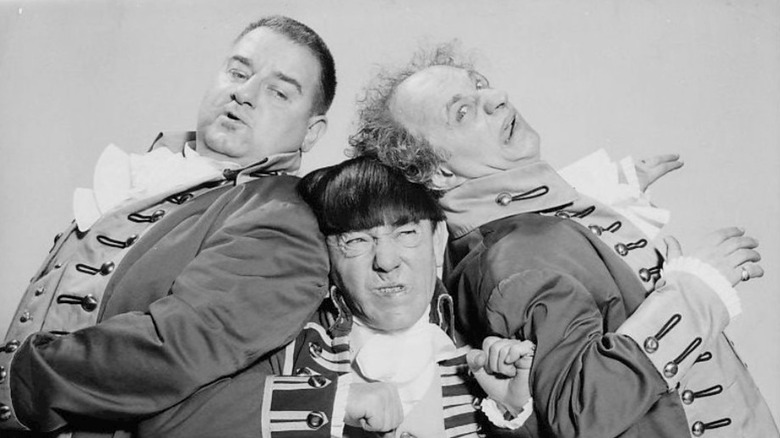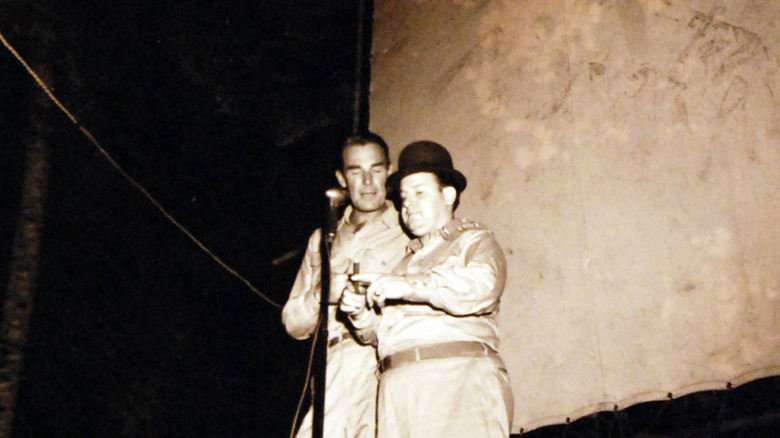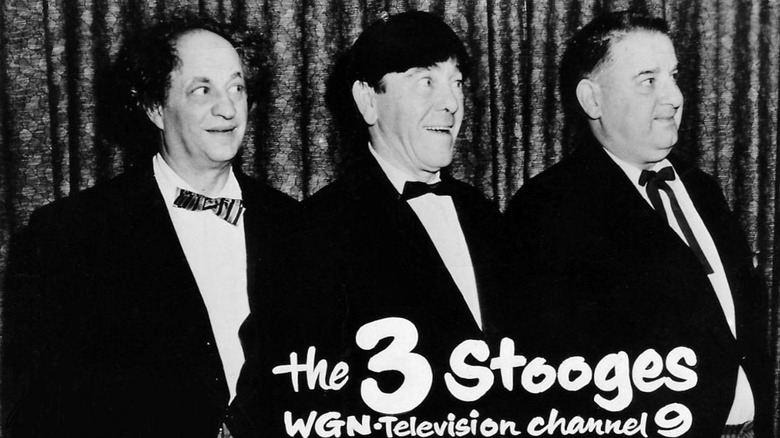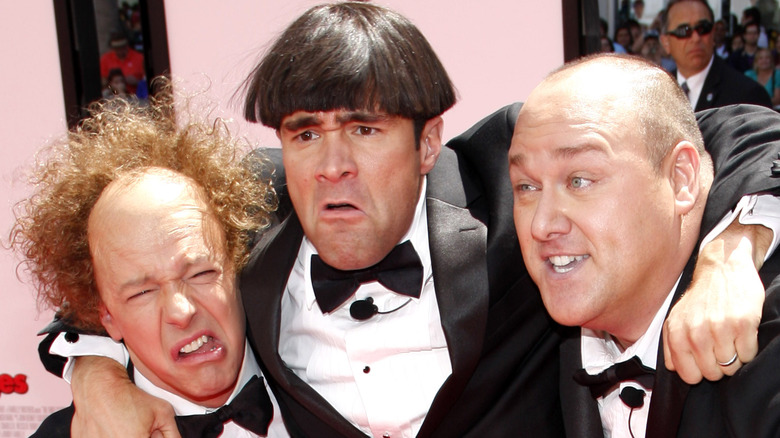The Timeline Of All Six Of The Three Stooges Explained
They give meaning to the warning, "don't try this at home." They're the example shown to barbers of what not to do with a haircut. They've been the darling of young filmgoers and TV viewers well after they ceased to be. They are the Three Stooges — all six of them.
Not that there were ever more than three stooges at a time, at least in a professional sense. According to Britannica, the act began when Samuel and Moses Horwitz — stage names Shemp and Moe Howard — joined forces with Moe's pal Ted Healy for a vaudeville comedy act in 1922. When Larry Fine was added three years later, they became Ted Healy and his Stooges, with the standard routine being the Howards and Fine destroying whatever earnest performance Healy tried to deliver.
Money, and Healy's unstable behavior, drove Shemp out of the act, and later broke the Stooges off entirely. With another Howard brother, known to the world as Curly, the newly-christened Three Stooges became household names. Under that name, they were active on the silver screen from the 1930s to the 1960s, with several personnel changes along the way. Moe and Fine were always there, but four different stooges occupied the third slot, with changes necessitated by family tragedies, business considerations, or both. It's a lot to keep track of, so here is a timeline of the major career and personal developments of the six Three Stooges.
The Howards are born
The backbone of the Three Stooges was the Howard brothers. Born to Solomon and Jennie Gorovitz — whose surname was changed to Horwitz with U.S. immigration (via Michael Fleming's "The Three Stooges: Amalgamated Morons to American Icons") — the brothers went through another name change when they arrived in Hollywood: Howard.
The first brother who went on to stoogedom (per Britannica) was Samuel, born on March 17, 1895, in New York City. The world would come to know him as Shemp, the nickname he acquired from his Lithuanian mother's awkward pronunciation of "Sam" (per Turner Classic Movies). Moses "Moe" Horwitz was born on June 19, 1897, in New York as well. In his autobiography "I Stooged to Conquer," Moe claimed that his father called him an "ugly" baby and that the family butcher predicted he would be a girl. Jerome Horwitz came on October 22, 1903. Audiences would one day call him Curly, but to his family, he was known as Babe (per Fleming).
Moe enters show business
Moses Horwitz was the first of his family to catch the acting bug. While an avid reader, the future Moe Howard was a regular truant, put off by bullying classmates and the call of the stage. Turner Classic Movies reports that Moe was often in a theater seat when he should have been at school, and he only made it two months into high school before deciding to forego formal education.
His earliest performances were done for fun on Coney Island, but Moe's first professional break came when he was hired as a gofer for Vitagraph Studios in Brooklyn. The company occasionally offered him minor roles in their films, and big brother Samuel "Shemp" Howard performed with Moe in vaudeville, saloons, and even a riverboat.
Another performing partner was comedian Ted Healy, and it was with Healy that the Howards started down the path that led to the Three Stooges. The three formed Ted Healy and his Racketeers in 1922, with the Racketeers later dubbed Stooges. A typical performance saw Healy try to tell jokes or sing songs as Moe and Shemp heckled and cavorted. Ted Healy and his Stooges won success on vaudeville, Broadway, and the movies by the end of the 1920s, and while marriage made Moe briefly reconsider his chosen profession, he stayed on every step of the way.
They create a unique style with their haircuts
Call it a bowl cut, a mushroom cut, or a mop top. By any name, it was one of Moe Howard's trademarks. Throughout his adult life, the leader of the Three Stooges always sported the same unnaturally sharp fringe of hair. Paired with the curly remnants of Larry Fine's thinning hair and his brother Curly Howard's round shaved head, it seemed to fit. But Moe's haircut wasn't exclusively for comic purposes.
In a late-in-life talk show appearance, Moe explained the story behind his childhood haircut. His mother persisted in styling his hair with shoulder-length curls until he was 11 years old. The teasing from his schoolmates pulled Moe into fight after fight. Finally, on the advice of a friend, Moe took a pair of scissors and sheared himself. The result was none too neat, but Moe kept the look in mind and adopted it when he grew up.
Moe wasn't the only stooge with a story behind his hair. Before Curly joined the Three Stooges, he wore his hair long and had a mustache to boot, per Michael Fleming's "The Three Stooges: Amalgamated Morons to American Icons." He had rather sporty looks, and Ted Healy, the ringleader of the act at the time, felt he would be out of place alongside Moe and Fine. To appease Healy, Curly reluctantly buzzed his head.
Larry Fine transforms from violinist to stooge
The Howard brothers and Ted Healy may have founded the iconic act, but besides Moe Howard, the one constant over the decades was the balding, frizzy-haired Larry Fine from the Three Stooges. Not being a Howard or an old family friend, Fine could have had his own career, and in fact, he did. According to Turner Classic Movies, he dabbled in boxing and sang with Gus Edwards, and earned a name in vaudeville as a combination comedian and violinist. This talent went back to his childhood when a doctor recommended Larry play the violin as a way to rebuild arm strength after an accident spilling a toxic substance left him with serious burns.
Fine the fiddling funnyman (not an alliterative moniker he ever used) first came to the Stooges' attention in 1925 when the Howards and Healy caught a performance of his in Chicago. The impression he left was enough for Moe to recommend Fine to Healy as a possible replacement when Moe's brother Shemp temporarily left the act. Healy agreed on one condition: The violin had to go. As compensation, he threw in an extra $10 on top of Fine's $90-a-week contract.
Jerome joins the Stooges as Curly
Not every ingredient of a hit act is present right from the start. Routines develop with practice, inspiration comes in sudden bursts, and fresh blood can make all the difference. Jerome Howard was relatively late in joining his big brother Moe and Larry Fine as a member of Ted Healy and his Stooges, but in the rascal persona of Curly, he became the darling of generations of fans.
According to Turner Classic Movies, Curly looked up to Moe and Shemp Howard from a young age. His early efforts to follow in their footsteps were more musical than comedic. He sang, danced, and conducted bands, albeit with a breakaway suit. The chance to get in on stoogedom came when Shemp, who often clashed with Healy, decided to go his own way. Moe's first choice for a replacement was his baby brother Curly, and Healy acquiesced — at the price of Curly's hair.
The youngest Howard may have been eager to join his brother and his partners on stage, but according to Michael Fleming's "The Three Stooges: Amalgamated Morons to American Icons," Curly suffered from stage fright. In his early days as a stooge, it was so bad that it pitched his voice higher. Far from hurting his performance, the high voice and Curly's improvisational instincts helped to define his on-screen character.
The Three Stooges go their own way
Ted Healy was the first to assemble the future Three Stooges in one act, but he was a difficult man to work with. Often drunk, he was also controlling and tight-fisted. When the Stooges briefly struck out on their own, Healy allegedly called in a bomb threat, according to Michael Fleming's "The Three Stooges: Amalgamated Morons to American Icons." It was just that sort of episode that helped convince Shemp Howard to leave the act.
Moe and Curly Howard, with Larry Fine, remained as Healy's stooges for a while longer. But in the early 1930s, Hollywood beckoned. MGM signed the act for work in features and short subjects, often built around stock footage (per Fleming). The good notices Healy picked up convinced him to renew with MGM for a solo career in features, with the Stooges left behind. But the Stooges were picking up their own fans by this time.
Cut loose from their mercurial partner, in 1934 they formally adopted the name the Three Stooges and won deals with two studios, Columbia and Universal. Unfortunately, they had been negotiated at the same time: Moe went to Columbia, Fine went to Universal, and neither knew the other was bartering until they both came back with contracts. Per Fleming, an hour's difference made the Columbia deal binding, and it made the studio the Stooges' home base for the next 24 years — during which they never got a raise (per Britannica).
Shemp became the ugliest man in Hollywood
While his brothers Moe and Curly Howard, and Larry Fine, reached new heights of fame as the Three Stooges at Columbia, Shemp Howard established himself as a comedian in his own right. He was slow to follow the Stooges and other acts to Hollywood. According to Turner Classic Movies, after leaving the family act in 1930, Shemp stayed in Brooklyn for another seven years. In that time, he built himself up in two-reel shorts, slowly moving from bit player to star. As Knobby Walsh, he often stole the show from the title character of the Joe Palooka series.
At one point, per the Jewish Virtual Library, Shemp attempted to create a group act of his own in the short film "The Knife of the Party," but it didn't work out. Fortunately for Shemp, he was still in demand, even if not always in the most flattering terms, with his agent once promoting him as "the ugliest man in Hollywood." When he finally went west, he co-starred with everyone from Abbott and Costello to John Wayne. A regular employer was Columbia Pictures, the home studio of the Three Stooges.
Shemp re-joined the act after Curly suffered a stroke
Posterity might never have remembered any line-up of the Three Stooges other than Moe Howard, Larry Fine, and Curly Howard if not for a personal tragedy. Curly liked to live fast, and success gave him ample opportunity to enjoy rich food and drink. The same career that let him indulge taxed his energies, and he turned to the same vices to cope with the stress, at the cost of his many marriages. On top of his wild behavior, Curly suffered from hypertension (per Turner Classic Movies).
His deteriorating health was noticeable on screen by the 1940s, but things came to a head during the filming of "Half-Wits Holiday" in 1946. A massive stroke left Curly unable to perform, and a second stroke the following year put him in a wheelchair. With the act suddenly short one member, Moe and Fine appealed to the older Howard brother, Shemp, whose solo career was going steady. While reluctant to give up his own work, Shemp agreed to fill in with the Three Stooges, assuming that Curly would make a full recovery.
Sadly, Curly's condition only deteriorated. Per Michael Fleming's "The Three Stooges: Amalgamated Morons to American Icons," he had sufficient energy for a bit part in "Hold That Lion" in 1947, making it the only Three Stooges film to feature all three Howard brothers together. But he was eventually committed to a sanitarium, and he died in 1952 at just 48 years old.
Comedian Joe Besser joins the Stooges
At the beginning of the 1950s, the Three Stooges — consisting now of Moe and Shemp Howard and Larry Fine — were still churning out shorts and features for Columbia. Elsewhere in Hollywood, Joe Besser was enjoying his own career. He'd been garnering notices since the 1940s when he appeared in the Broadway hit "Sons of Fun" according to his obituary in The New York Times. Besser's comic persona was that of a simpering man-child, and this Three Stooges star was more recognizable for his part in another legendary comic team: He played Stinky in "The Abbott and Costello Show." He even had his own catchphrase on the show (via Turner Classic Movies): "I'll harm you."
Besser fell in with the Stooges with Shemp's death in 1955. Having lost two brothers, Moe was still a willing performer under contract with Columbia, and neither he nor Fine were inclined to work on their own. It was up to Moe and Columbia to select a replacement stooge, according to Michael Fleming's "The Three Stooges: Amalgamated Morons to American Icons." They settled on Besser due to his established act, which Moe and Fine were aware of, and Besser's own contract with Columbia. Per the Times, Besser found another catchphrase in his new role of Joe the stooge: When abused by Moe, he'd whine, "Oooh, you crazy!"
Columbia dropped the Stooges, and so did Besser
Joe Besser's tenure with the Three Stooges was short-lived. He had the bad luck to join the act at a time when short films were falling out of favor with audiences and studios. According to Michael Fleming's "The Three Stooges: Amalgamated Morons to American Icons," Columbia was having doubts as early as 1955, the year Shemp Howard died. By 1957, they were the only studio still making live-action shorts, according to Empire. After the death of studio chief Harry Cohn, the department was shuttered, and the Stooges were unemployed.
Even without production and distribution woes, the Stooges found the partnership with Besser an awkward one. His wimpy persona didn't mesh well with the violent slapstick of Moe Howard and Larry Fine, and he personally had a low tolerance for getting hit. He departed the act after the break with Columbia, though recollections vary as to why. A former crew member claimed that Moe said Besser was Columbia's choice to replace his brother Shemp and not someone he and Fine sought to retain later. Moe himself said that Besser declined to continue because of a sick wife.
Joe DeRita joins the Stooges
The last man to join the Three Stooges had roots in show business stretching back to before he was born. He was Joseph Wardell, who would be known professionally as Joe DeRita. DeRita was born in Philadelphia on July 12, 1909, to a stagehand father and a dancer mother, according to the Three Stooges' official website. His parents brought him onto the stage at just 7 years old, and he continued on the vaudeville circuit as a young man.
DeRita began transitioning into films in 1944 with an appearance in "The Doughgirls." He remained steadily employed throughout World War II, partnering with various famous names for ISO work and moving on to radio and television at the war's end. He also put in appearances in short subjects at Columbia, where the Three Stooges were based.
Curiously, DeRita didn't hold the Stooges in especially high regard. In "The Three Stooges Scrapbook," he is quoted saying, "They were physical, but they just didn't have any humor about them ...I was with the Stooges for 12 years, and it was a very pleasant association, but I just don't think they were funny." He compared the Stooges unfavorably to Laurel and Hardy and cited the predictability of their antics, given away by conspicuous props, as a reason for not liking their humor.
The Stooges' popularity on TV influenced the Curly Joe persona
Joe DeRita was reluctant to join the Three Stooges when Moe Howard extended the offer in 1958 (per the Three Stooges' official website). He had his own established career by then. His agent was against it, early trial performances didn't bode well, and the initial pay was terrible, according to Michael Fleming's "The Three Stooges: Amalgamated Morons to American Icons." Fleming suggests that after so many years going it alone, DeRita may have wanted a more settled arrangement. He may also have been playing the long game, foreseeing that association with the Stooges would pay off eventually.
Around the time that DeRita joined the act, Columbia Pictures sold the television rights to their extensive catalog of Stooges short films, reviving the group's popularity just in time for Moe, DeRita, and Larry Fine's initial round of personal appearances. The most beloved of the old shorts came from Curly Howard's tenure, and that had a direct impact on DeRita's persona. He initially wore his hair in parted curtains, like Shemp Howard's, but children who attended live shows expected Curly, according to Jeff Lenburg's "The Three Stooges Scrapbook." While unwilling to imitate Curly, the rotund DeRita did shave his head to accentuate a slight resemblance with the late Howard brother and adopted the name Curly Joe for good measure.
Larry's stroke effectively ended the act
After Joe DeRita joined the act as Curly Joe, the Three Stooges spent the '60s performing, cameoing in TV shows, and starring in six feature-length films (per Turner Classic Movies). But none of them were young men anymore. Larry Fine in particular struggled to maintain the necessary energy for the Stooges' trademark slapstick, and a series of minor strokes made it increasingly difficult for him to remember his lines (per TCM). He persisted until 1970 when a more severe stroke left him paralyzed on the left side.
Moe Howard, the ringleader of the Stooges, had been prepared to replace his brothers Curly and Shemp when illness struck, and he considered bringing supporting actor Emil Sitka in to take Fine's place. But no projects ever came together with Sitka. Fine's incapacitation effectively ended the act, and he died in January 1975. Moe died only five months later from lung cancer. DeRita briefly attempted to carry on with two stand-ins for Moe and Fine, and reportedly had Moe's permission to do so under the Three Stooges name, according to Jeff Lenburg's "The Three Stooges Scrapbook." But this venture flopped with hardly any notice.
